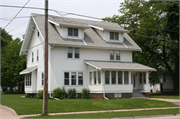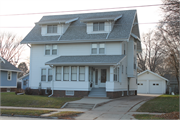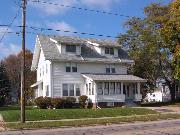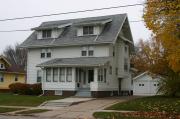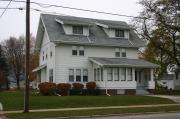| Additional Information: | A 'site file' exists for this property. It contains additional information such as correspondence, newspaper clippings, or historical information. It is a public record and may be viewed in person at the Wisconsin Historical Society, State Historic Preservation Office.
2013: George Challoner, of the Wilkin-Challoner Company, constructed a home on the west side of North Main Street in 1926. His grandfather, of the same name, founded a shingle and sawmill machinery manufacturing company in 1865 in nearby Omro, Wisconsin. After moving the company to Oshkosh in 1887, the Challoner Company grew to employ 25 to 50 employees. At the time of the older George Challoner’s death, his sons Frank and John Challoner took over operation of the business. In 1905, after Frank’s death, John partnered with Theodore S. Wilkin and reorganized the business as the Wilkin-Challoner Company manufacturing woodworking machinery. George Challoner, son of John, joined the family business by 1908. George worked as a draftsman initially and was a bookkeeper by 1912, chief clerk by 1916, and superintendent by 1920. George assumed the position of vice-president around 1926 and president by 1928, the position which he held until his death in 1942. He is buried in the Omro cemetery. In 1945, the company was reorganized as the CKL Machinery Company. George’s wife, Adelia, continued living in the couple’s home on North Main Street until her death in 1986.
The modestly-sized, two-and-one-half-story George & Adelia Challoner House is generally rectangular in plan with the exception of a one-story projecting bay centered on the front facade. Its exterior, presumed to have been originally covered with wooden clapboards, is clad with vinyl siding. The house features a wide wooden skirt board above the brick foundation. The front of the projecting bay contains four wooden 3-over-1-light double-hung windows; two of the same windows are located on each of the bay’s two sides. A pair of double-hung replacement windows is located to the left of the bay at the first floor level; and to its right, an entry door flanked on each side by a full-height sidelight. The shallowly-pitched shed roof with wide overhanging eaves which covers the front projecting bay extends to its right to the north side of the front façade covering a porch to shelter the entry door. This small porch features a vinyl-sided half-wall supporting a single, wooden square, corner column that also features a wooden bracket. The area above the half-wall, between the column and the northeast corner of the main block, has been infilled with three double-hung windows. Two pairs of double-hung replacement windows at the second floor level divide the front façade roughly into thirds. A small, one-story bay projects from at the far left of the south side façade at the first floor level, contains a grouping of three double-hung replacement windows, and is covered by a moderately-pitched shed roof. Another projecting bay, covered by a steeply pitched shed roof with wide overhanging eaves, is located on the building’s north side façade beginning half-way above the first floor level and ending half-way above the attic floor level, presumably housing the landings of an interior staircase. All shed and gable ends are framed with wide wooden bargeboards.
|
|---|
| Bibliographic References: | Oshkosh City Directories, Various Years 1900-1960. On file at the Oshkosh Public Library, Oshkosh, Wisconsin.
City of Oshkosh Assessment Data. City of Oshkosh website. <http://www.ci.oshkosh.wi.us> Accessed Nov. 6, 2012.
Randall, George, compiler. Illustrated Atlas of Winnebago County, Wisconsin. Madison, Wisconsin: Brant & Fuller, 1889, page 47.
Lawson, Publius V. History of Winnebago County, Wisconsin – It’s Cities, Towns, Resources, People Volume I. Chicago: C. F. Cooper & Co., 1908, page 809.
Oshkosh Daily Northwestern, September 27, 1927.
Karstaedt, Clinton F., ed.. Oshkosh, One Hundred Years a City: 1853-1953. Oshkosh, Wisconsin: Oshkosh Centennial, Inc., 1953, page 215.
“Extensive Line of Woodworking Machinery Made at CKL Plant.” CKL Manufacturing file of the Oshkosh Business & Industry Collection of the Oshkosh Public Library, Oshkosh, Wisconsin.
www.findagrave.com/memorial/55888898
"N. Main Street Survey," WisDOT ID #4994-01-14/15, Prepared by Heritage Research (2013). |
|---|

